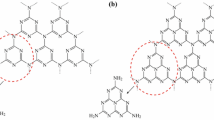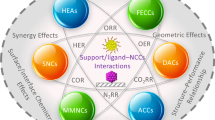Abstract
Cathodic oxygen reduction reaction (ORR) is a highly important electrochemical reaction in renewable-energy technologies. In general, the surface area, exposed facets and electrical conductivity of catalysts all play important roles in determining their electrocatalytic activities, while their performance durability can be improved by integration with supporting materials. In this work, we have developed a method to synthesize hybrid structures between PtPd bimetallic nanocages and graphene by employing selective epitaxial growth of single-crystal Pt shells on Pd nanocubes supported on reduced graphene oxide (rGO), followed by Pd etching. The hollow nature, {100} surface facets and bimetallic composition of PtPd nanocages, together with the good conductivity and stability of graphene, enable high electrocatalytic performance in ORR. The obtained PtPd nanocage–rGO structures exhibit mass activity (0.534 A·mg −1Pt ) and specific activity (0.482 mA·cm−2) which are 4.4 times and 3.9 times greater than the corresponding values for Pt/C.

Similar content being viewed by others
References
Zhang, J.; Sasaki, K.; Sutter, E.; Adzic, R. R. Stabilization of platinum oxygen-reduction electrocatalysts using gold clusters. Science 2007, 315, 220–222.
Steele, B. C. H.; Heinzel, A. Materials for fuel-cell technologies. Nature 2001, 414, 345–352.
Guo, S. J.; Zhang, S.; Sun, S. H. Tuning nanoparticle catalysis for the oxygen reduction reaction. Angew. Chem. Int. Ed. 2013, 52, 8526–8544.
Cheng, F. Y.; Chen, J. Metal–air batteries: From oxygen reduction electrochemistry to cathode catalysts. Chem. Soc. Rev. 2012, 41, 2172–2192.
Li, Y. G.; Dai, H. J. Recent advances in zinc-air batteries. Chem. Soc. Rev. 2014, 43, 5257–5275.
Zhu, C. Z.; Dong, S. J. Recent progress in graphene-based nanomaterials as advanced electrocatalysts towards oxygen reduction reaction. Nanoscale 2013, 5, 1753–1767.
Cao, R. G.; Lee, J. S.; Liu, M. L.; Cho, J. Recent progress in non-precious catalysts for metal-air batteries. Adv. Energy Mater. 2012, 2, 816–829.
Choi, R.; Choi, S. I.; Choi, C. H.; Nam, K. M.; Woo, S. I.; Park, J. T.; Han, S. W. Designed synthesis of well-defined Pd@Pt core–shell nanoparticles with controlled shell thickness as efficient oxygen reduction electrocatalysts. Chem. Eur. J. 2013, 19, 8190–8198.
Zhang, L.; Lyyamperumal, R.; Yancey, D. F.; Crooks, R. M.; Henkelman, G. Design of Pt-shell nanoparticles with alloy cores for the oxygen reduction reaction. ACS Nano 2013, 7, 9168–9172.
Greeley, J.; Stephens, I. E. L.; Bondarenko, A. S.; Johansson, T. P.; Hansen, H. A.; Jaramillo, T. F.; Rossmeisl, J.; Chorkendorff, I.; Norskov, J. K. Alloys of platinum and early transition metals as oxygen reduction electrocatalysts. Nat. Chem. 2009, 1, 552–556.
Cui, C. H.; Gan, L.; Li, H. H.; Yu, S. H.; Heggen, M.; Strasser, P. Octahedral PtNi nanoparticle catalysts: Exceptional oxygen reduction activity by tuning the alloy particle surface composition. Nano Lett. 2012, 12, 5885–5889.
Ma, L.; Wang, C. M.; Gong, M.; Liao, L. W.; Long, R.; Wang, J. G.; Wu, D.; Zhong, W.; Kim, M. J.; Chen, Y. X. et al. Control over the branched structures of platinum nanocrystals for electrocatalytic applications. ACS Nano 2012, 6, 9797–9806.
Long, R.; Zhou, S.; Wiley, B. J.; Xiong, Y. J. Oxidative etching for controlled synthesis of metal nanocrystals: Atomic addition and subtraction. Chem. Soc. Rev. 2014, 43, 6288–6310.
Kinoshita, K. Particle size effects for oxygen reduction on highly dispersed platinum in acid electrolytes. J. Electrochem. Soc. 1990, 137, 845–848.
Markovic, N. M.; Gasteiger, H. A.; Ross, P. N. Oxygen reduction on platinum low-index single-crystal surfaces in sulfuric acid solution: Rotating ring-Pt(hkl) disk studies. J. Phys. Chem. 1995, 99, 3411–3415.
Wang, C.; Daimon, H.; Onodera, T.; Koda, T.; Sun, S. H. A general approach to the size- and shape-controlled synthesis of platinum nanoparticles and their catalytic reduction of oxygen. Angew. Chem. Int. Ed. 2008, 47, 3588–3591.
Wang, C. M.; Ma, L.; Liao, L. W.; Bai, S.; Long, R.; Zuo, M.; Xiong, Y. J. A unique platinum–graphene hybrid structure for high activity and durability in oxygen reduction reaction. Sci. Rep. 2013, 3, 2580.
Bai, S.; Xiong, Y. J. Recent advances in two-dimensional nanostructures for catalysis applications. Sci. Adv. Mater., in press, DOI: 10.1166/sam.2015.2261.
Li, Y. J.; Li, Y. J.; Zhu, E. B.; McLouth, T.; Chiu, C. Y.; Huang, X. Q.; Huang, Y. Stabilization of high-performance oxygen reduction reaction Pt electrocatalyst supported on reduced graphene oxide/carbon black composite. J. Am. Chem. Soc. 2012, 134, 12326–12329.
Song, Y. J.; Garcia, R. M.; Dorin, R. M.; Wang, H. R.; Qiu, Y.; Shelnutt, J. A. Synthesis of platinum nanocages by using liposomes containing photocatalyst molecules. Angew. Chem. Int. Ed. 2006, 45, 8126–8130.
Wu, R.; Kong, Q. C.; Fu, C. L.; Lai, S. Q.; Ye, C.; Liu, J. Y.; Chen, Y. X.; Hu, J. Q. One-pot synthesis and enhanced catalytic performance of Pd and Pt nanocages via galvanic replacement reactions. RSC Adv. 2013, 3, 12577–12580.
Bai, S.; Wang, C. M.; Deng, M. S.; Gong, M.; Bai, Y.; Jiang, J.; Xiong, Y. J. Surface polarization matters: Enhancing the hydrogen-evolution reaction by shrinking Pt shells in Pt–Pd–graphene stack structures. Angew. Chem. Int. Ed. 2014, 53, 12120–12124.
Wang, L.; Yamauchi, Y. Metallic nanocages: Synthesis of bimetallic Pt-Pd hollow nanoparticles with dendritic shells by selective chemical etching. J. Am. Chem. Soc. 2013, 135, 16762–16765.
Yoon, T.; Mun, J. H.; Cho, B. J.; Kim, T. S. Penetration and lateral diffusion characteristics of polycrystalline graphene barriers. Nanoscale 2014, 6, 151–156.
Skrabalak, S. E.; Au, L.; Li, X. D.; Xia, Y. N. Facile synthesis of Ag nanocubes and Au nanocages. Nat. Protoc. 2007, 2, 2182–2190.
Xiong, Y. J.; Wiley, B.; Chen, J. Y.; Li, Z. Y.; Yin, Y. D.; Xia, Y. N. Corrosion-based synthesis of single-crystal Pd nanoboxes and nanocages and their surface plasmon properties. Angew. Chem. Int. Ed. 2005, 44, 7913–7917.
Zhu, C. Z.; Guo, S. J.; Fang, Y. X.; Dong, S. J. Reducing sugar: New functional molecules for the green synthesis of graphene nanosheets. ACS Nano 2010, 4, 2429–2437.
Seo, S.; Yoon, Y.; Lee, J.; Park, Y.; Lee, H. Nitrogen-doped partially reduced graphene oxide rewritable nonvolatile memory. ACS Nano 2013, 7, 3607–3615.
Xia, B. Y.; Wang, B.; Wu. H. B.; Liu, Z. L.; Wang, X.; Lou, X. W. Sandwich-structured TiO2–Pt–graphene ternary hybrid electrocatalysts with high efficiency and stability. J. Mater. Chem. 2012, 22, 16499–16505.
Bai, Y.; Long, R.; Wang, C. M.; Gong, M.; Li, Y. R.; Huang, H.; Xu, H.; Li, Z. Q.; Deng, M. S.; Xiong, Y. J. Activation of specific sites on cubic nanocrystals: A new pathway for controlled epitaxial growth towards catalytic applications. J. Mater. Chem. A 2013, 1, 4228–4235.
Kakade, B. A.; Wang, H. L.; Tamaki, T.; Ohashi, H.; Yamaguchi, T. Enhanced oxygen reduction reaction by bimetallic CoPt and PdPt nanocrystals. RSC Adv. 2013, 3, 10487–10496.
Lindström, R. W.; Kortsdottir, K.; Wesselmark, M.; Oyarce, A.; Lagergren, C.; Lindbergh, G. Active area determination of porous Pt electrodes used in polymer electrolyte fuel cells: Temperature and humidity effects. J. Electrochem. Soc. 2010, 157, B1795–B1801.
Lee, S. J.; Mukerjee, S.; McBreen, J.; Rho, Y. W.; Kho, Y. T.; Lee, T. H. Effects of Nafion impregnation on performances of PEMFC electrodes. Electrochim. Acta 1998, 43, 3693–3701.
Nesselberger, M.; Ashton, S.; Meier, J. C.; Katsounaros, I.; Mayrhofer, K. J. J.; Arenz, M. The particle size effect on the oxygen reduction reaction activity of Pt catalysts: Influence of electrolyte and relation to single crystal models. J. Am. Chem. Soc. 2011, 133, 17428–17433.
Peng, Z. M.; Yang, H. Designer platinum nanoparticles: Control of shape, composition in alloy, nanostructure and electrocatalytic property. Nano Today 2009, 4, 143–164.
Clouser, S. J.; Huang, J. C.; Yeager, E. Temperature dependence of the Tafel slope for oxygen reduction on platinum in concentrated phosphoric acid. J. Appl. Electrochem. 1993, 23, 597–605.
Ghoneim, M. M.; Clouser, S.; Yeager, E. Oxygen reduction kinetics in deuterated phosphoric acid. J. Electrochem. Soc. 1985, 132, 1160–1162.
Tan, Y. M.; Xu, C. F.; Chen, G. X.; Zheng, N. F.; Xie, Q. J. A graphene–platinum nanoparticles–ionic liquid composite catalyst for methanol-tolerant oxygen reduction reaction. Energy Environ. Sci. 2012, 5, 6923–6927.
Liang, Y. Y.; Li, Y. G.; Wang, H. L.; Zhou, J. G.; Wang, J.; Regier, T.; Dai, H. J. Co3O4 nanocrystals on graphene as a synergistic catalyst for oxygen reduction reaction. Nat. Mater. 2011, 10, 780–786.
Lim, B.; Jiang, M. J.; Camargo, P. H. C.; Cho, E. C.; Tao, J.; Lu, X. M.; Zhu, Y. M.; Xia, Y. N. Pd–Pt bimetallic nanodendrites with high activity for oxygen reduction. Science 2009, 324, 1302–1305.
Peng, Z. M.; Yang, H. Synthesis and oxygen reduction electrocatalytic property of Pt–on–Pd bimetallic heteronanostructures. J. Am. Chem. Soc. 2009, 131, 7542–7543.
Si, W. F.; Li, J.; Li, H. Q.; Li, S. S.; Yin, J.; Xu, H.; Guo, X. W.; Zhang, T.; Song, Y. J. Light-controlled synthesis of uniform platinum nanodendrites with markedly enhanced electrocatalytic activity. Nano Res. 2013, 6, 720–725.
Zheng, F. L.; Wong, W. T.; Yung, K. F. Facile design of Au@Pt core–shell nanostructures: Formation of Pt submonolayers with tunable coverage and their applications in electrocatalysis. Nano Res. 2014, 7, 410–417.
Author information
Authors and Affiliations
Corresponding authors
Electronic supplementary material
Rights and permissions
About this article
Cite this article
Bai, S., Wang, C., Jiang, W. et al. Etching approach to hybrid structures of PtPd nanocages and graphene for efficient oxygen reduction reaction catalysts. Nano Res. 8, 2789–2799 (2015). https://doi.org/10.1007/s12274-015-0770-6
Received:
Revised:
Accepted:
Published:
Issue Date:
DOI: https://doi.org/10.1007/s12274-015-0770-6




